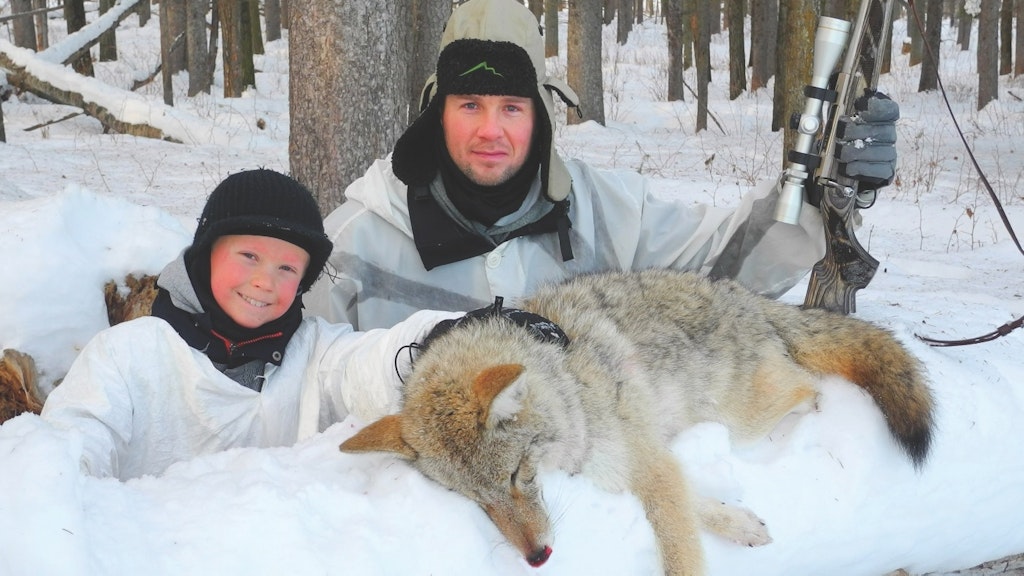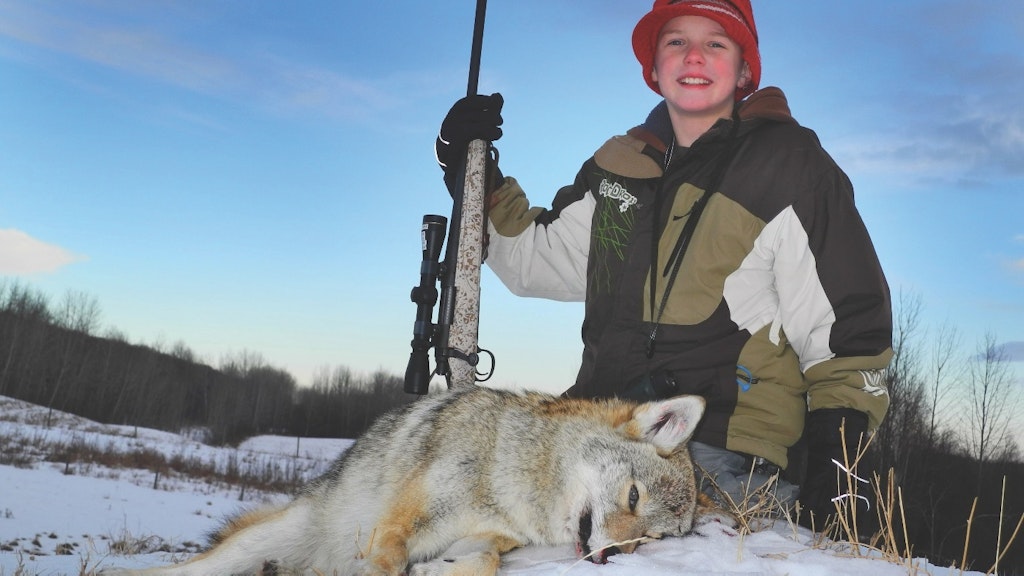I’m of the opinion that one of the greatest responsibilities we have as predator hunters is to pass on the skills and traditions of the hunt to the next generation. As a result, I’m constantly on the lookout for people who have never had the opportunity to engage in coyote hunting. Often, these are young people, but sometimes the not so young fit this category, too. I lost count long ago of how many novice hunters I’ve helped bag their first coyote, but considering I try to take at least one new person under my wing each year and I’ve been at this for more than 40 years, it’s a lot.
Who and Why
Learning any skill is best done with help from those with experience in the subject, and we’ve all had help in developing predator hunting expertise. The fortunate ones among us have had an active mentor in our lives, for others it has come down to learning from books, magazines and videos. But even then, someone took the time to write those words and film the videos. Those creative efforts often simply spring from a heart of generosity, and that’s probably the first thing to know about helping a new hunter get that first coyote.
I know myself well enough to know I’m not naturally generous with time or resources, but I recognize it’s a skill I’ve had to learn. Generosity was the topic of conversation in our living room this past month when some friends gathered, and when I mentioned my natural tendency, someone asked me how I learned to be generous. Pointing at my wife, I said, “Just marry someone with a generous heart. That’ll do it.”
Family members wanting to learn the ways of the hunter become a natural recipient of our generosity, but we need to stay alert for others in our circle who could benefit as well. I’ve found eager recipients at my church, in my neighborhood and by donating one-time coyote hunts at local charity auctions. Some of these people have gone on to become life-long friends and regular hunting partners.
If a likely candidate pops up on my radar, I look for a basic level of maturity and lots of enthusiasm. Age doesn’t matter much, but if they are really young, then I’ll only take them out if a parent or guardian comes along. Some have never fired a “real” gun before, while others are experienced hunters in other disciplines but entirely new to predator hunting. A recent example is Bob, a seasoned waterfowl and big-game hunter who had never taken a coyote. We took care of that in short order one day, and he repaid me with some delicious wild game sausage.
A recent example at the other end of the spectrum is Wes, a 17-year-old with a passion for hunting. His family is fully supportive of him, but with no hunters anywhere in sight, they were at a loss as to how to get him started right. So, why not me? And Wes repays me with his enthusiasm, which helps get a gray-haired coyote hunter off the couch and into the field.
Submitting my first offer for a one-day coyote hunt to a charity auction was a risk, simply because there’s no control over who will be the highest bidder. However, I’ve never had a bad experience. All my “clients” have been top-notch people who are fun to hang out with. A charity gets all the money and I go coyote hunting with some new friends. It’s a win for everyone.
And yes, I always provide the truck and fuel, lend out a rifle and provide the ammo, and we go to the spots I’ve scouted and obtained permission at. It’s called generosity. If you don’t get it, I can have my wife explain it to you. Just expect to be finger-wagged in the process.
How and When
As you’d expect, the procedure I use to get newbie predator hunters in front of their first coyote varies depending on the experience they have. In my jurisdiction there is no license required to hunt coyotes on private land and there is no bag limit or closed season, which all helps to simplify things. However, if the person has limited experience with firearms, I’ll insist on a trip to a shooting range before setting out afield. There I’ll spend a few hours running them through some basic gun safety rules and getting them comfortable behind a rifle.
Specifically, I’ll get my student to practice shooting from a sitting position with a bipod at typical coyote hunting distances, which for me are inside 200 yards. My preferred target is from Birchwood Casey and has a realistic image of a coyote with the vital zone marked in red. Coaching them into hits on this target, under simulated hunting conditions, really boosts confidence for the actual hunt. While at the range, we’ll also work on loading and unloading safely, as I’ll insist on walking into and out of our hunt location with an empty chamber.
When hunt day rolls around, I’ll try and pick a spot to hunt that doesn’t require arriving in the dark. Although crack-of-dawn hours are the most productive, I’ll hunt in full daylight if possible. This gives me the opportunity to supervise the new hunter more closely and makes it easier for them because they can readily see what’s going on and what they are doing.
Calling is the preferred method of getting that first coyote standing in front of a new hunter, but I’ve also waited over bait piles successfully. How close I sit to the newbie is a direct reflection of how confident I am in their abilities to manage on their own. And I don’t mean just safety. Instruction on when to shoot is critical, and the occasional whisper about staying calm and squeezing the trigger — not jerking it — all contributes to a successful first attempt.
Guns and Gear
Be prepared to supply all the equipment needed for a novice’s first hunt, although I do draw the line at lunch, which I expect them to bring. This gear, of course, includes the rifle and ammo, and here I’ve found the .223 Rem. to be the perfect chambering. It’s relatively inexpensive and quiet, while still delivering plenty of punch for those shorter-range shots preferred for new hunters. If suppressors are legal in your area, they are a wonderful choice. However, they aren’t an option for me, so hearing protection is something I supply. It can consist of simple foam earplugs, but I prefer electronic hearing protection so the novice can hear my whispered instructions.
If smaller sized people are the ones being escorted afield, the rifle should, whenever possible, be modified to fit. Fortunately, there are lots of rifles with adjustable buttstock length available, and as long as this dimension can be accommodated, I’ve found people can adapt to everything else. A modern sporting rifle with a carbine-style stock works well, as do bolt-action rifles set in an adjustable chassis system. A rifle support, such as a bipod is essential to help the novice hunter make a perfect shot. And here I favor a bipod that attaches to the rifle, because it’s simpler to manipulate, and when things get exciting for that newbie, simple is best.
I’ve used both semi-auto and bolt-action rifles with my protégés and find either one works fine. I usually just default to whatever is available and sighted-in at the time.
A good optic with a generous eye-box and large exit pupil is important to success. Although, picking up a target animal in a riflescope is second nature to experienced hunters, this isn’t the case for new shooters and is something they can struggle with. So, keep the scope’s magnification low to increase field of view, thus giving that novice the best possible chance of finding a coyote in the scope quickly and making a successful shot.
Proper clothing is important for the rookie, but camouflage isn’t. By this I mean it’s far more important they be comfortable than it is they wear the perfect camo pattern. This is especially important for those of us who hunt during the winter months, in locations where snow and cold are the norm. I’d rather have my student comfortable and able to sit quietly, than perfectly concealed and shivering from the cold. So, I ensure they have season-appropriate clothing to wear. If I think it’s needed, I have camo coverups, which I supply to help keep them hidden.
I do coach them a bit about scent control, specifically to avoid highly perfumed products. While that alone will never prevent a coyote from smelling them, it does serve to get them tuned into the fact that coyotes rely extensively on their noses.
Hits and Misses
On game day it’s important to read the rookie’s demeanor and adjust supervision accordingly. If there’s a lot of anxiety evident, sit close and coach them through every step. But if confidence and maturity are on display, it’s OK to give them some freedom.
I’ve found most new hunters, especially those I’ve made a range trip with, can deliver reasonably accurate shots. Hitting isn’t usually a problem but knowing when to shoot is. I’ve had my students shoot when the coyote is much too far away, as well as wait for them to get unrealistically close. One memorable student, before I could stop him, opened up on an arriving pair of coyotes when they were screened by heavy brush. Of course, he was unsuccessful. Some students seem to solve the when-to-shoot question intuitively and get it right every time, while others need careful coaching as the coyote approaches in order to make the correct call. This is, after all, the moment when the adrenaline spike hits, and rational thought can be the first casualty.
Experienced hunters all know adrenaline can turn a brain to mush. And while it’s a rush for the student, this is when everything they’ve learned about gun safety can disappear. In that post shooting period, I’ve gently but firmly taken a rifle away from a youngster until they’ve settled down. Then, in the debriefing we discussed what happened and why.
Down and Dead
When the shooting is over, that debriefing time is important, whether there’s a dead coyote on the ground or not. This is the time to discuss how the stand played out, what went right, and what went wrong. It’s also the time to encourage the student, especially if the coyote ran off unscathed. This is when I’ll trot out some of my own stories about shots I’ve missed, of which there is no shortage. We are all good at beating ourselves up over a missed shot, so a rookie needs to hear some encouraging and sympathetic words when it happens to them.
However, if there’s fur on the ground, it’s time to celebrate. Encouragement is needed now as well. This first coyote is a big deal, recognize that. Take lots of photos, give them a chance to call or text parents or friends to share the success. This was the goal, and they’ve achieved it. Congratulate yourself, too. You’ve fulfilled a tremendous responsibility by passing on some skills and traditions of the hunt and have given someone an experience they will never forget. Your generosity of time and resources has made a difference in someone’s life.








